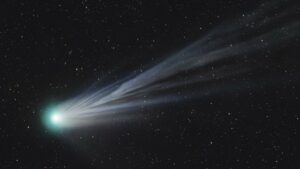 A massive comet, nicknamed “devil comet”, will become visible for the first time in 71 years during the upcoming total solar eclipse next month.
A massive comet, nicknamed “devil comet”, will become visible for the first time in 71 years during the upcoming total solar eclipse next month.
The comet, officially designated as 12P/Pons-Brooks, is a cryovolcanic body characterized by its formation of two “horn”-like structures from ice and gas, along with periodic explosive events.
According to NASA, comets are celestial objects composed of dust, frozen gases, ice, and rocks that coalesced after the solar system’s formation. The “devil comet” is approaching its next perihelion, the point in its orbit closest to the sun, where it will be most luminous, expected on April 21. This celestial occurrence aligns with the total solar eclipse on April 8 across North America, casting a shadow from Texas to Maine as the moon obscures the sun.
A rare comet known as the “Devil Comet” could make an appearance during the total solar eclipse on Monday. https://t.co/DrNqYazigG
— WFAA (@wfaa) April 5, 2024
NASA suggests that the total darkness during the eclipse might offer sky enthusiasts a unique opportunity to observe the night sky’s stars, planets, and possibly the 12P/Pons-Brooks comet as it makes its journey through the solar system. The comet is slated to make its nearest approach to Earth on June 2, providing another chance to witness it. However, its visibility may decrease compared to during the eclipse due to its distance from the sun. Similar to the well-known Halley’s comet, which orbits the sun every 76 years, 12P/Pons-Brooks is classified as a short-period comet with an orbital cycle of 71 years, last observed in 1954.
Researchers have determined that the “devil comet” has a minimum diameter of 17 kilometers (about 10.5 miles). It underwent a significant brightening in July 2023, becoming 100 times more luminous, and has exhibited several explosive bursts on subsequent dates, highlighting its dynamic nature.
